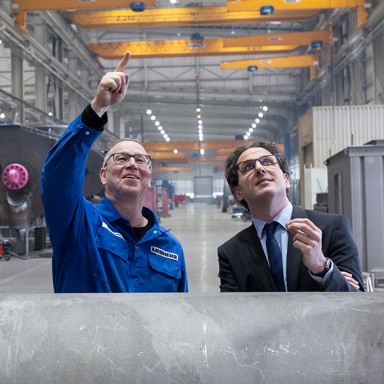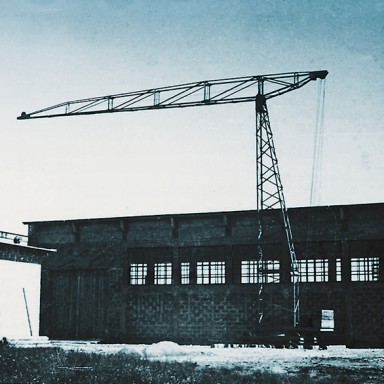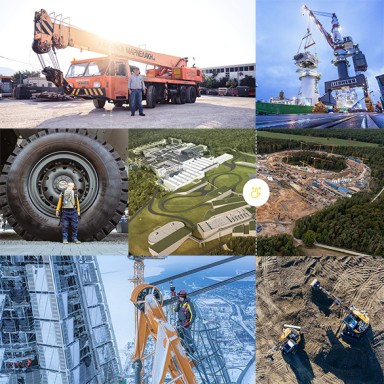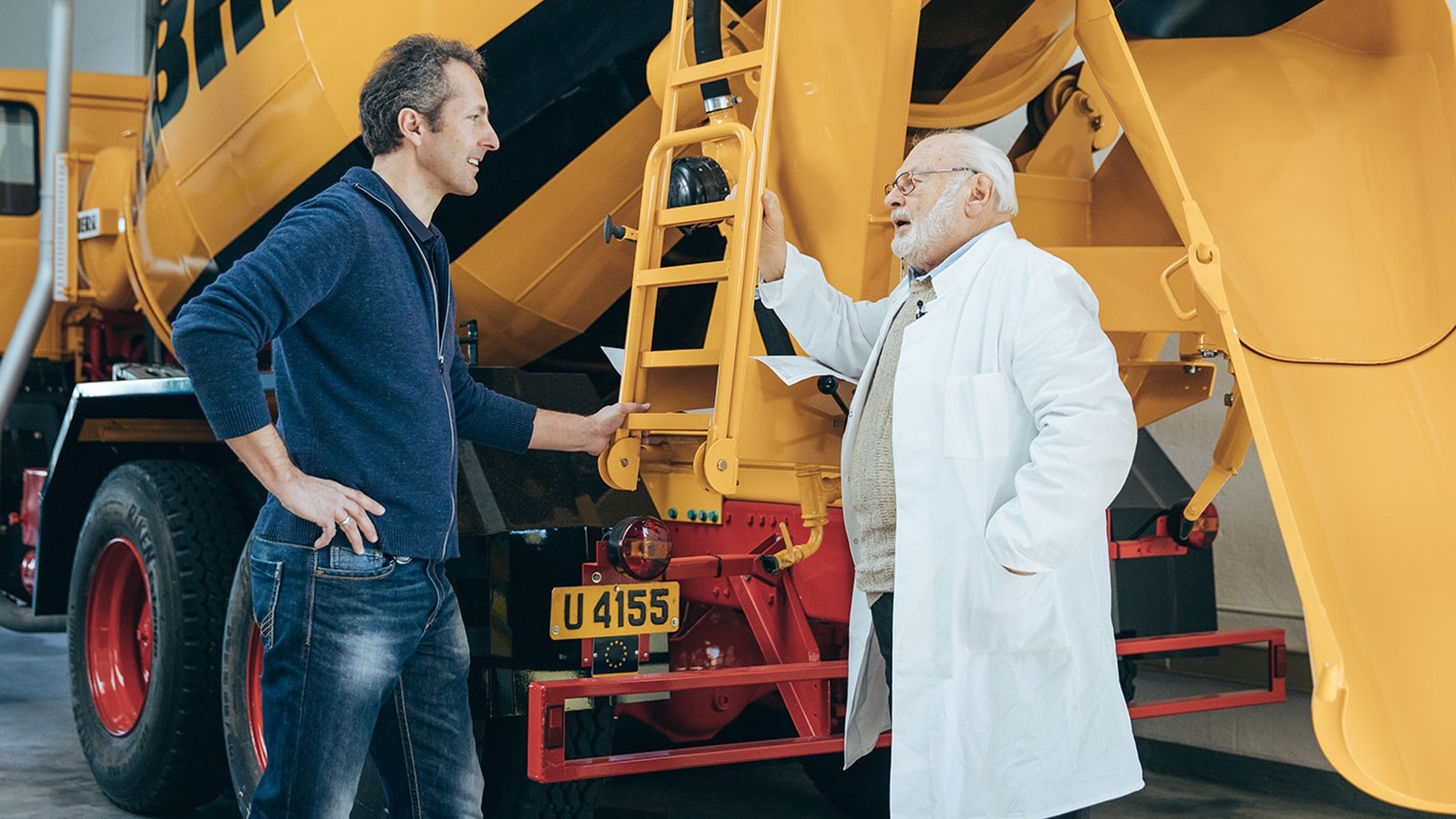
7 minutes reading time
In one line
In the technical design office truck mixers take shape. Working methods have changed in recent decades, but design engineers’ enthusiasm for innovation remains the same today.
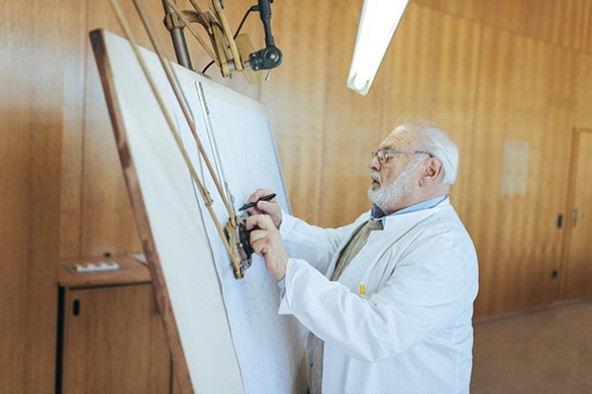
Looking back
It was no easy task getting hold of a drawing board. ‘They’d simply all been tossed out at some point,’ says Klaus Günther. So the 79-year-old was all the more surprised and delighted when one was set up specially for him in the training room at the Bad Schussenried plant. It was here that one of the first production companies of the Liebherr Group was founded in 1954, and where Günther joined the company as one of its first trainees the following year.
Today, Günther, who once headed the design office, is paying a visit to his former workplace to exchange ideas with the new generation. He has many stories to tell. In his heyday, he had been in charge of coordinating up to 30 design engineers at a time.
The truck mixer has not changed much in terms of its basic design. After all, the physics of mixing are exactly the same.
The ink stain as a trademark
Back then, everything revolved around the drawing board. Rulers were attached to the drafting head at the end of a moveable scissor-type drafting machine – exactly like the one in the training room. Günther carefully places his hand on the drafting machine. ‘With this, you could create a precise design on A0 paper with exact angles,’ he says. At that time, the design engineers usually worked standing up. ‘The hallmarks of the design engineers were their ties, their white lab coats and the pens in their front pockets that often left ink stains,’ he recalls with a smile.
By the time he retired in 2001, Günther had witnessed the department’s transformation into the digital age. In the 1990s, the drawing board was gradually replaced by digital design tools. Today, computer-aided design (CAD) allows design engineers to create the most complex blueprints in 3D format, all within the confines of a computer screen – a far cry from the drawing board of the past.
By clicking on “ACCEPT”, you consent to the data transmission to Google for this video pursuant to Art. 6 para. 1 point a GDPR. If you do not want to consent to each YouTube video individually in the future and want to be able to load them without this blocker, you can also select “Always accept YouTube videos” and thus also consent to the respectively associated data transmissions to Google for all other YouTube videos that you will access on our website in the future.
You can withdraw given consents at any time with effect for the future and thus prevent the further transmission of your data by deselecting the respective service under “Miscellaneous services (optional)” in the settings (later also accessible via the “Privacy Settings” in the footer of our website).
For further information, please refer to our Data Protection Declaration and the Google Privacy Policy.*Google Ireland Limited, Gordon House, Barrow Street, Dublin 4, Ireland; parent company: Google LLC, 1600 Amphitheatre Parkway, Mountain View, CA 94043, USA** Note: The data transfer to the USA associated with the data transmission to Google takes place on the basis of the European Commission’s adequacy decision of 10 July 2023 (EU-U.S. Data Privacy Framework).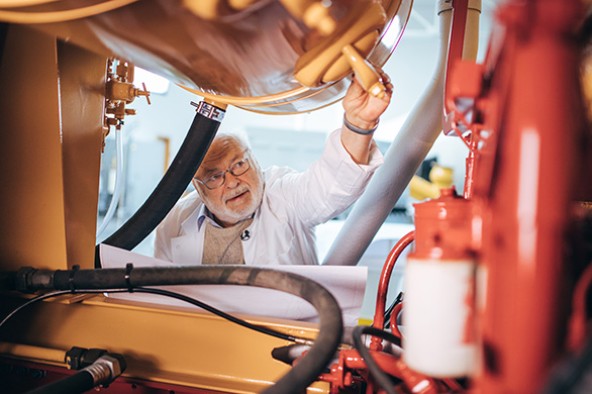
Ideas from the top
Klaus Günther recalls that when they were designing on the drawing board, design engineers always had to have a clear view of the finished product in mind. ‘There was always a moment of truth when we would test the design in the workshop.’
In the early years, the company’s founder played a very hands-on role in coming up with new ideas. ‘Hans Liebherr used to enjoy dropping by the office and saying, “I have an idea.” Then we’d give him a pencil and paper and he’d start drawing,’ recalls Günther.
‘We had some lively debates with him. Many of his ideas were groundbreaking. Some led nowhere, and others were simply too far ahead of their time,’ says Günther. ‘The first hydraulic truck mixer, which we launched at the Hannover trade fair in 1968, was an idea that literally came all the way from the top.’
By clicking on “ACCEPT”, you consent to the data transmission to Google for this video pursuant to Art. 6 para. 1 point a GDPR. If you do not want to consent to each YouTube video individually in the future and want to be able to load them without this blocker, you can also select “Always accept YouTube videos” and thus also consent to the respectively associated data transmissions to Google for all other YouTube videos that you will access on our website in the future.
You can withdraw given consents at any time with effect for the future and thus prevent the further transmission of your data by deselecting the respective service under “Miscellaneous services (optional)” in the settings (later also accessible via the “Privacy Settings” in the footer of our website).
For further information, please refer to our Data Protection Declaration and the Google Privacy Policy.*Google Ireland Limited, Gordon House, Barrow Street, Dublin 4, Ireland; parent company: Google LLC, 1600 Amphitheatre Parkway, Mountain View, CA 94043, USA** Note: The data transfer to the USA associated with the data transmission to Google takes place on the basis of the European Commission’s adequacy decision of 10 July 2023 (EU-U.S. Data Privacy Framework).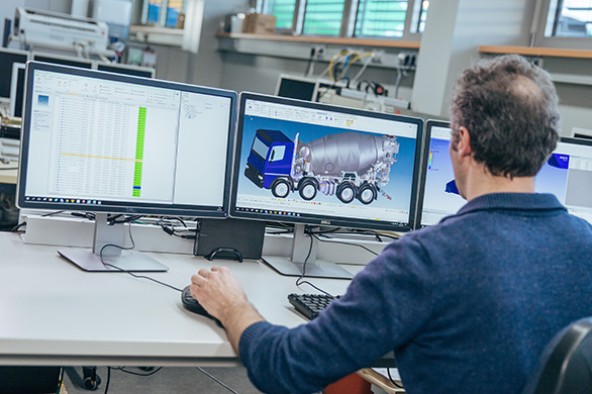
Topics, that stay current
‘Tradition is very important,’ says Berthold Ruf, who started working as a development engineer for Liebherr Mischtechnik GmbH in 2002, one year after the departure of Klaus Günther. By that time, the drawing board had long been superseded by digital design programmes. The white lab coat and mandatory tie that once comprised the design engineer’s uniform were also long gone.
Ruf enjoys talking shop with a design engineer like Günther, who was around in the early days of the company. ‘Even with our latest fifth-generation truck mixers, we’re still dealing with many of the same issues as back then. It’s all about the technicalities of optimising load capacity and axle load distribution, while keeping everything as safe and efficient as possible,’ says Ruf.
‘Of course,’ he adds, ‘we have it a bit easier now than the design engineers did back in the early days. 3D design enables us to integrate more and more parameters, so we can simulate and model different kinds of load distributions and dimensions. This enables us to work more quickly, so we can focus more on the product and development process itself, without being too distracted by technical details.’
By clicking on “ACCEPT”, you consent to the data transmission to Google for this video pursuant to Art. 6 para. 1 point a GDPR. If you do not want to consent to each YouTube video individually in the future and want to be able to load them without this blocker, you can also select “Always accept YouTube videos” and thus also consent to the respectively associated data transmissions to Google for all other YouTube videos that you will access on our website in the future.
You can withdraw given consents at any time with effect for the future and thus prevent the further transmission of your data by deselecting the respective service under “Miscellaneous services (optional)” in the settings (later also accessible via the “Privacy Settings” in the footer of our website).
For further information, please refer to our Data Protection Declaration and the Google Privacy Policy.*Google Ireland Limited, Gordon House, Barrow Street, Dublin 4, Ireland; parent company: Google LLC, 1600 Amphitheatre Parkway, Mountain View, CA 94043, USA** Note: The data transfer to the USA associated with the data transmission to Google takes place on the basis of the European Commission’s adequacy decision of 10 July 2023 (EU-U.S. Data Privacy Framework).Our goal is to lead from the front. At Liebherr, we have the freedom to think differently and try new things.
The founder wishes you ‘All the best’
Electrical drive trains, telemetrics, driver assistance systems, networking and digitisation: ‘The world of truck mixers keeps moving ahead and we’re doing our part to keep the wheels turning,’ Ruf tells his predecessor. So, it’s just a question of more IT specialists then? ‘On the contrary, it still comes down to classic engineering skills. Like when we’re talking about designing steel components to weigh less but still offer the same load-bearing capacity and lifespan.’
And it’s always been that way, as Klaus Günther points out. ‘Every kilo of weight we can save on the truck is an extra kilo that the customer can transport on the road. For them, that’s money in the bank.’
Even though the times and job descriptions have changed, the goals of the design engineers are the same as always. To prove this point, Klaus Günther brought along a promotional postcard from the early days of the company, written to stir up interest among customers for the HTM6 truck mixer. It contained a message that came straight from the top: ‘Discover the HTM6’s many advantages for yourself – and make them all yours. All the best, Hans Liebherr.’


